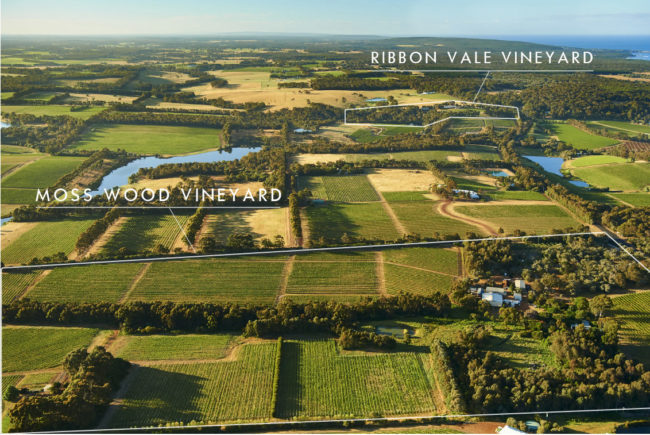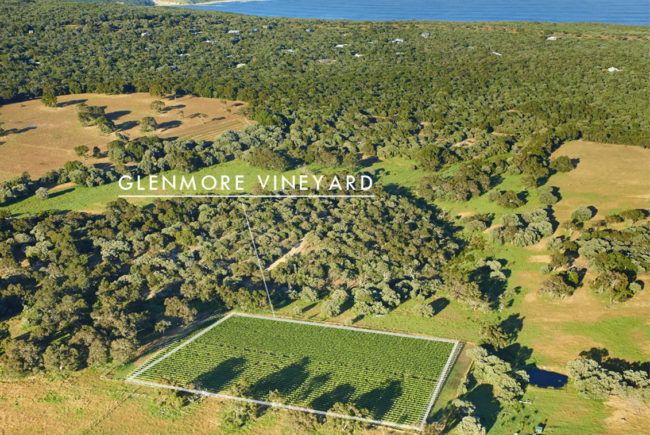The Moss Wood and Ribbon Vale Vineyards are located in the Wilyabrup sub-region, the heart of the Margaret River wine region.
At 33° 78’ south latitude, 115° 18’ east longitude and approximately three hours south of Perth, Western Australia’s capital city, Margaret River is recognised as one of the world’s great wine producing regions. The emphasis at Moss Wood in the vineyard and winery is on the highest quality hand production and continuing reference to viticultural and winemaking technical advances.
Climate and viticulture
Margaret River is on the south-western tip of the Australian continent at latitude 33° 78’ degrees south. It has a maritime climate and avoids both summer and winter extremes. The ocean also benefits the area as the consistent summer sea breeze maintains a relatively high humidity.
Rainfall
Long term average annual rainfall 1125mm
Long term average rainfall Oct-March 190mm
The Year in the Vineyard
Early June to August
Vineyard maintenance: pruning, trellis maintenance.
Budburst Chardonnay - mid August
September to Early January
Spray program to combat fungal disease.
Budburst Cabernet - late September
Flowering Chardonnay - late October
Flowering Cabernet - late November
Veraison (colour change)- Chardonnay early January
Veraison (colour change)- Pinot Noir mid January
Mid November to Mid January
Attention to foliage placement and trimming to ensure proper organisation of the vine canopy. This allows easy penetration of sprays and maximum exposure of bunches and leaves for optimum ripeness.
February to April
Vintage (hand harvest).
Veraison (colour change)- Cabernet early February
Sustainability
Winemaking
Moss Wood Cabernet Sauvignon
- Old vines, dry-grown, low yielding vineyard
- Hand plunging in open fermenters 3-4 times per day
- Average 28 months ageing in 225 litre, French oak barrels, 25% new
Moss Wood Chardonnay
- Old vines, dry-grown, low yielding vineyard
- Mendosa and Dijon clones
- Whole bunch pressed and barrel fermented
- 18 months aging in 225 litre French oak barrels, 50% new
- Full malolactic fermentation, combines great fruit depth with complexity
moss wood semillon
- Old vines, dry-grown, low yielding vineyard
- Fermented in stainless steel tanks
- Neutral yeast allowing full expression of varietal characteristics
moss wood pinot noir
- Old vines, dry-grown, low yielding vineyard
- Oldest Pinot Noir vineyard in Margaret River
- Cold soaked on skins prior to fermentation, maximising extraction of colour and flavour
- Hand plunging 3 to 4 times a day
- 18 months aging in 225 litre French oak barrels, 33% new
Ribbon Vale Cabernet Sauvignon
- Old vines, dry-grown, low yielding vineyard
- Fermented in open fermenters, hand plunged, 3-4 times per day
- 24 months aging in 225 litre French oak barrels, 15% new
Ribbon Vale Merlot
- Old vines, dry-grown, low yielding vineyard
- Fermented in open fermenters, hand plunged 3-4
times per day - 24 months aging in 225 litre French oak barrels,
20% new
Ribbon Vale elsa
- Sauvignon Blanc
- Primary fermentation: half in stainless steel and half in 228 litre French oak barrels (10% new)
- Full malolactic fermentation in 228 litre French oak barrels (10% new)
- Aging for 10 months in 228 litre French oak barrels (10% new)
Moss Wood Amy's
- Blended of Cabernet Sauvignon, Petit Verdot, Malbec, and Merlot
- Each variety picked and fermented separately
- Extraction of colour and flavour by pump over, up to 3 times per day
- Aging for 12 months in 225 litre French oak barrels
- Production and aging techniques designed specifically for early drinking
Vineyards
Moss Wood Vineyard - Wilyabrup, Margaret River Wine Region
- First planted in 1969
- 11.78 hectares, on gentle north and east facing slopes
- Unirrigated
- Scott Henry (Chardonny and Pinot Noir) and Te Kauwhata Two Tier ( Cabernet Franc, Merlot and Petit Verdot) trellising to reduce the density of the foliage and expose the grapes to more sunlight
- Soils ranging from sandy loam to a gravelly, red-brown loam, over clay subsoil
- Row spacings on old plantings of 3.6 metres
- Closer planting in new sections down to 2.5 metres
- Soil conservation techniques of minimum tillage and mulching, maintains a heathy abundance of earth worms and soil microflora and fauna
Ribbon Vale Vineyard - Wilyabrup, Margaret River Wine Region
- First planted in 1977
- 6.36 hectares planted on south and west facing slopes
- Unirrigated
- Scott Henry trellising system
- Soils are classic gravelly loams over clay sub-soils
- Row spacings on old plantings of 3.6 metres
- Closer planting in new sections down to 2.5 metres
- Soil conservation techniques of minimum tillage and mulching, maintaining a heathy abundance of earth worms and soil microflora and fauna
Amy's, Glenmore Vineyard - Margaret River Wine Region
- Sourced from Glenmore Farm, Yallingup
- Located 10kms north of Moss Wood
- Planted in 1990
- North-facing vineyard, with gravelly, red-brown loam soil, over clay subsoil
- Read the story of Amy


Screw Cap Closure
We proudly and exclusively seals our wines with the superior screw capclosure. Widely accepted and selected within Australia and by many discerning wine aficionados around the world.
WHY WE DECIDED TO ONLY USE SCREW CAP CLOSURE
For many years we had been frustrated with the high rate of cork taint and random bottle oxidation caused by the use of cork. We were very suspicious that many corks do not seal well at all and the wine under those corks is ageing far more quickly than it should.
We began the use of screw cap closures with our 2000 vintage of Moss Wood Cabernet Sauvignon. Consumers supported the new closure, to the point where we quickly decided to completely stop sealing our wines with cork. More than 15 years of experience has allowed us to draw to the conclusion that the standard of the screw cap product and the method of application provides a much more consistent product with a very satisfying ageing ability. The bottles with screw cap closures are very consistent and taste virtually identical.
Some advice about screw cap closure
For all their benefits, screw cap closures are not perfect and can leak if not applied correctly. If any of our products are found to have this problem, please contact the winery and we will exchange them.
Customers should also be aware that the screw cap is not pilfer or tamper-proof. Please ensure that the seal has not been broken before purchasing a bottle. In addition, when buying a wine in a restaurant, the customer must insist that it be opened at the table. This guards against receiving a damaged bottle.
For those who enjoy the romance of wine, one final point regarding the purchase of a screw cap closed wine in a restaurant. While the wine will not be cork tainted, customers should insist that the sommelier allow them to taste before accepting the bottle as it may not be perfect for other reasons. These would include damage during transport or improper storage.
“Screwcaps provide the perfect seal, with different types of liner allowing differing levels of oxygen transfer (reduction – a sort of cabbagey stink – was once a common problem associated with screwcaps being too airtight, allowing no oxygen ingress at all). […]
So far it seems as though screwcaps are much more effective than other stoppers at retaining the natural fruitiness of wine, so seem particularly suitable for aromatic wines such as Sauvignon Blanc and Riesling. […] One thing is sure: screwcaps are generally used by producers anxious to maximise the quality of the wine encountered by their customers.” Jancis Robinson (source)
–
“it takes time and expertise to learn how to make wine bottled under screwcap. […] Screwcaps are indeed a great initiative. ” Tim Atkins (source)
–
“Stelvin, the screw cap of choice, will become the standard for a majority of the world’s wines,” Robert Parker.
–
“A Washington winery found in a 30-month test that screw caps better preserved wines’ freshness than two synthetic closures and natural cork did.” Wine Spectator (source)
–
"What a strange industry we must appear to makers of other food and beverage sorts. We winos mostly continue to shrug our shoulders at common, regularly occurring incidences of a spoilage taint that can destroy even our rarest and most expensive of wine treasures. But for how much longer?
It is estimated by various sources—everyone from cork manufacturers to the screw cap folks and a whole crowd of agendas in between—that anywhere between 1-7% of all wines bottled under cork are “corked” to some extent.
It can take time for a winemaker to understand how to adjust pre-bottling preparations for screw cap, for their wines. Because screw caps are generally a more hermetic seal than cork, bottling with the same “free” sulfur dioxide (an antioxidant added to wine prior to bottling to offer protection from oxidation) level as a wine under cork may contribute the manifestation of rubbery “reduction” characters in the wine. And this was a common flaw in the early days of bottling wines under screw cap. But I’ve seen very few Australian or New Zealand screw cap wines suffering from reduction in recent years.
The other major complaint about screw caps is the rate at which wines age under them. In truth, I have no idea what that rate is…we wine experts are all kind of wait-and-see about this issue. Side-by-side trials seem to indicate that wines under screw cap do develop and evolve, yet they are generally developing slower and, well, differently than the same wines under cork. Mind you, at least a bottle under screw cap will evolve more or less precisely the same as bottles of the same wine if kept under the same conditions (e.g. in the same case), which is more than can be said for bottles under cork.
New Zealand and Australia are a little unusual in their near total rejection of using natural cork to seal wine bottles. Collectors of wines from these countries will likely note that Antipodean wines from the 1990s and early 2000s seem to have significantly higher incidences of cork taint than wines from some other countries closer to the source of cork production. I say “seem to” because no studies have been carried out to support this theory. Yet the anecdotal evidence was black and white enough for the New Zealand- and Australia-based wineries that got fed up with the unacceptably high incidences of cork taint that they were experiencing. What started in Clare Valley, Australia in 2000 as a defiant stance against cork taint spread to a movement in New Zealand in 2001 and screw caps became the norm throughout both countries by around 2004 and 2005. The Aussie-Kiwi message to the big European cork manufacturers was as clear as that of the 1984 Twisted Sister song, “We’re not gonna take it anymore!”" Lisa Perrotti Brown MW Robert Parker (full article)
